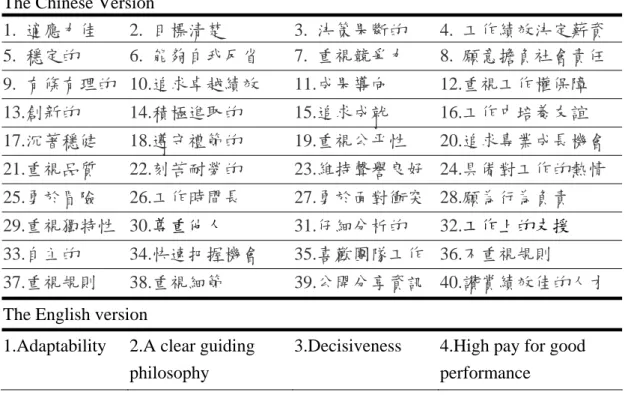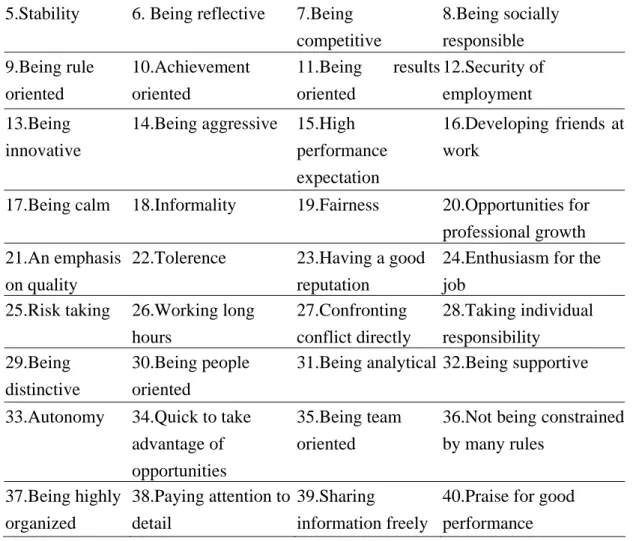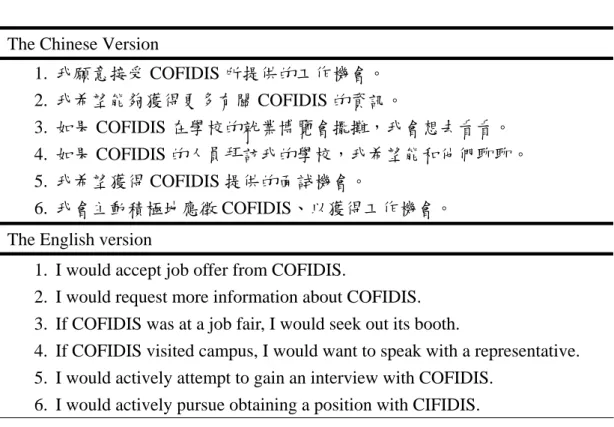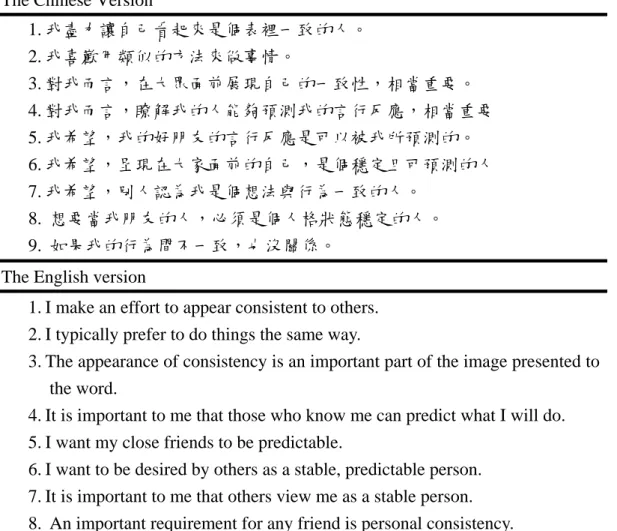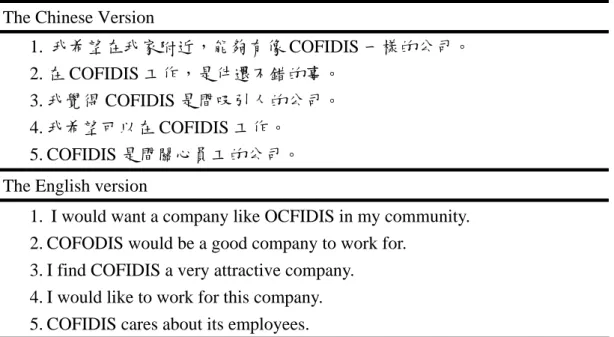CHAPTER III METHODOLOGY Pilot Study
To test the hypotheses, a fictional company, COFIDIS created by researcher, was used to enhance the internal validity of the study, and to avoid the confounding effects of participants’ perceptions or experiences about the target organization caused by using an actual company. The information of the fictional company included company background, company value, job openings, the information of compensation and benefits, and the information of training and development.
Based on the past findings, it was believed that company providing high pay, good benefits, ample training opportunities, and internal promotion path is attractive to most applicants (Aiman-Smith et al., 2001;Boswell, Roehliing, Lepinel, &
Moynihan, 2003;Rynes & Barber, 1990). Therefore, for the purpose of manipulation, the information of compensation and benefits, as well as training and development were compiled to be either high or low attractive. Besides, all other information was the same.
After compiling the fictional company information, a pilot study was conducted.
There were two purposes of pilot study. One was to formulate the company value profile used to calculate the objective P-O fit index. The other was to check the effects of manipulation.
The pilot study was conducted in the following procedures and all materials used were shown in the Appendix A. Consistent with the previous research (Dineen et al., 2002), 10 graduate school students were randomly assigned to read either high (see Appendix A-1) or low (see Appendix A-2) attractive fictional company information used in the formal experiment. Then, they were asked to read the instruction (see Appendix A-3) and complete OCP by sorting the 40 value items of OCP into 9
categories ranging from most to least characteristics of company value.
In order to make it easier for the applicants to complete OCP, some equipment was made. First, 40 cards were made, and 40 value items of OCP were printed on each card. Therefore, one card represented one value characteristic (see Appendix A-4). Second, a figure of nine columns was printed on a piece of paper. The size of each box in the figure was the same as the size of card (see Appendix A-5). With these equipments, participants were asked to complete the OCP in the following steps.
First, each participant was asked to pick out 9 cards with the most characteristics of company value first and put them in section A. In turn, pick out 9 cards with the least characteristics of company value put them in section B. Thus, 22 cards would be left (see Appendix A-6). Second, participants were asked to sort the 9 cards of the most characteristics into three categories in section A in the figure and sort the 9 cards of the least characteristics into three categories in section B in the figure. Then, participants were asked to sort the 22 cards into three categories in the middle part of the figure. Finally, cards in each category were distributed into the boxes without order. Each box only received one card. At this moment, OCP was completed and each card was sorted into an appropriate box ranging from most to least characteristics of company value to present the company value profile (see Appendix A-7).
Then, each item was scored from 1 to 9 points depending on the category it belonged to. For example, items in the category of least characteristics of company value were scored 1 point, and items in the category of most characteristics of company value were scored 9 points. Following this logic, items in other categories were scored from 2 to 8 points in order. Therefore, each of the 40 items got its points.
Then, total points of each item assigned by all raters were averaged by 10, because there were 10 raters. The averaged points of each of the 40 items represented the
company value profile which would be used to calculate the objective P-O fit index.
Consistent with O’Reilly et al. (1991), two indexes were calculated to see the reliability of the company profile among all of the raters. First, Spearman-Brown formula for the reliability was calculated (α=.90) (Block, 1978). Besides, R(wg)(James, Demaree, & Wolf, 1984 ) was calculated (R(wg)=.99). In addition, results from independent sample t-test showed that value perception of two groups (one group was composed of the raters reading high attraction information;the other group was composed of the raters reading low attraction information) was not significantly different. The high reliability showed that the value profile of the fictional company is perceived in the similar way by all raters.
After finishing the OCP, subjects were asked to complete the measurement of organization attraction, also used in the formal experiment, to check the manipulation effects (see Appendix A-8). The results indicated the mean difference between the two group of people was statistically significant (t=9.27, p<0.001). Therefore, the manipulation succeeded.
Formal Experiment
Data were collected at two time points in the formal experiment. At Time1, data were used for hypotheses testing. At Time2, data were used to examine the longitudinal effects. Subjects, experiment procedures, and instruments at both time points were shown below.
Subjects
All participants were recruited from graduate school and undergraduate school students who are either currently searching for a job or soon planning to engage in the recruiting process. Existing studies (e.g. Judge & Cable, 1997;Roberson et al., 2005) have relied on samples of students. It was supported that most proposition relationships did not vary considerably because of applicant type (Chapman et al., 2005).
Time1
A wanted advertisement was posted on the Bulletin Board System to recruit the participants. Each participant got one hundred NT dollars of coupon for his participation.
A total of eighty-three participants enrolled in the study at Time1. The participants included 48% men. The age of participants ranged from 21 to 27 years old, with the mean age of 23 years. The participants were students from one of the following schools: National Chengchi University (54%), National Taiwan University (21%), National Chen Kung University (12%), National Taiwan Normal University (10%), and National Taiwan University of Science and Technology (3%). The participants included 78% graduate school students, and 22% undergraduate school students. All participants will beginning searching for a job in 3 months (12%), 3 to 6
months later (15%), or 6 to 12 months later (73%). 66% of the participants had work experience as a part-time job, on the average, participants had 9 months of work experience.
Time2
After finishing the procedure at Time1, emails were sent to all the participants to invite them to participate in the study procedure at Time2. Each volunteer got a coupon of one hundred NT dollars for his participation.
A total of sixty participants, 72 percent of the participants at Time 1, enrolled in the study at Time2. The participants included 37% men. Participants ranged in age from 21 to 27 years old, with the mean age of 23 years. The participants were students from one of the following schools: National Chengchi University (65%), National Taiwan University (13%), National Chen Kung University (8%), National Taiwan Normal University (12%), and National Taiwan University of Science and Technology (2%). The participants included 73% graduate school students, and 27%
undergraduate school students. All participants will beginning searching for a job in 3 months (5%), between 3 months and 6 months later (15%), between 6 months and 12 months later (80%). 70% of the participants had work experience as a part-time job, on the average, participants had 9 months of work experience. Subjects at two time points were not significantly different on these characteristics except for the gender, and time for beginning of job search.
Procedures Time1
First of all, participants were asked to read a cover story to inform the purposes and procedures of the present study.
Following cover story, participants were asked to complete the OCP in the way the same as that in the pilot study, but the value items represented the personal value.
After completing the OCP, participants were randomly assigned to read fictional company information either high or low in organization attraction. The information provided here was the same as that in the pilot study.
Then, each participant was asked to complete a questionnaire that measured subjective P-O fit, application intention, PFC, organization attraction (for the purpose of manipulation check), and demographic information in order. All materials used in the formal experiment at Time1 were shown in the Appendix B.
Time2
Two weeks after Time1, voluntary participants were invited to complete a questionnaire without reading any company information. The questionnaire measured subjective P-O fit, organization attraction, and application intention in order. All materials used in the formal experiment at Time2 were shown in the Appendix C.
After completing all the procedures, debriefing letters were emailed to all the participants. The letter was shown in the Appendix D.
Instruments
All instruments were adapted from past research (in English) and translated into Chinese.
Time1
Objective P-O fit. Consistent with the past research (e.g. Dineen et al., 2002;
O’Reilly et al., 1991;Judge & Cable, 1997), the index of participants’ objective P-O fit was obtained by correlating participants’ personal value profile collected from formal experiment with the value profile of fictional company collected from pilot study. Both value profiles were draw from the Organizational Culture Profile (OCP).
In present study, 40-item version of the OCP introduced by Cable and Judge (1996) was adapted. The test-retest reliability of OCP over a year is .73 (O’Reilly et al., 1991). The 40 items were shown in Table 3.1.
Table 3.1 Forty Value Items of OCP The Chinese Version
1. 適應力佳 2. 目標清楚 3. 決策果斷的 4. 工作績效決定薪資 5. 穩定的 6. 能夠自我反省 7. 重視競爭力 8. 願意擔負社會責任 9. 有條有理的 10.追求卓越績效 11.成果導向 12.重視工作權保障 13.創新的 14.積極進取的 15.追求成就 16.工作中培養友誼 17.沉著穩健 18.遵守禮節的 19.重視公平性 20.追求專業成長機會 21.重視品質 22.刻苦耐勞的 23.維持聲譽良好 24.具備對工作的熱情 25.勇於冒險 26.工作時間長 27.勇於面對衝突 28.願為行為負責 29.重視獨特性 30.尊重他人 31.仔細分析的 32.工作上的支援 33.自主的 34.快速把握機會 35.喜歡團隊工作 36.不重視規則
37.重視規則 38.重視細節 39.公開分享資訊 40.讚賞績效佳的人才 The English version
1.Adaptability 2.A clear guiding philosophy
3.Decisiveness 4.High pay for good performance
5.Stability 6. Being reflective 7.Being competitive
8.Being socially responsible 9.Being rule
oriented
10.Achievement oriented
11.Being results oriented
12.Security of employment 13.Being
innovative
14.Being aggressive 15.High performance expectation
16.Developing friends at work
17.Being calm 18.Informality 19.Fairness 20.Opportunities for professional growth 21.An emphasis
on quality
22.Tolerence 23.Having a good reputation
24.Enthusiasm for the job
25.Risk taking 26.Working long hours
27.Confronting conflict directly
28.Taking individual responsibility
29.Being distinctive
30.Being people oriented
31.Being analytical 32.Being supportive
33.Autonomy 34.Quick to take advantage of opportunities
35.Being team oriented
36.Not being constrained by many rules
37.Being highly organized
38.Paying attention to detail
39.Sharing
information freely
40.Praise for good performance
Subjective P-O fit. This scale was used to assess the person-organization fit as value congruence. The scale consisted of 3 items rated on a 6-point Likert scale which ranged from “strongly disagree” to “strongly agree”. This scale was adapted from Cable and DeRue (2002). The coefficient alpha in the present study was .92. All the measurement items were shown in Table 3.2.
Table 3.2 Measurement Items of Subjective P-O Fit
The Chinese Version
1. 我對事物的看法與 COFIDIS 對事物的看法相似。
2. 我的價值觀與 COFIDIS 的公司價值觀相似。
3. COFIDIS 所重視的事情,與我所重視的事情相似。
The English version
1. The thing that I value in life are very similar to the thing that COFIDIS values.
Application intention. This scale was used to assess the respondents’ intentions to apply to the organization. The scale consisted of 6 items rated on a 6-point Likert scale which ranged from “strongly disagree” to “strongly agree”. This scale was adapted from Aiman-Smith et al. (2001). The coefficient alpha in the present study was .96. All the measurement items were shown in Table 3.3.
Table 3.3 Measurement Items of Application Intention
PFC. This scale was used to assess respondents’ preference for consistency. The scale consisted of 9 items rated on a 6-point Likert scale which ranged from “strongly disagree” to “strongly agree”. This scale was adapted from Cialdini et al. (1995). To increase the coefficient alpha in the present study from .62 to .77, item #9 was deleted.
All the measurement items were shown in Table 3.4.
2. My personal value matches COFIDIS’s values and cultures.
3. COFIDIS’s values and culture provide a good fit with the thing I value in my life.
The Chinese Version
1. 我願意接受 COFIDIS 所提供的工作機會。
2. 我希望能夠獲得更多有關 COFIDIS 的資訊。
3. 如果 COFIDIS 在學校的就業博覽會擺攤,我會想去看看。
4. 如果 COFIDIS 的人員拜訪我的學校,我希望能和他們聊聊。
5. 我希望獲得 COFIDIS 提供的面試機會。
6. 我會主動積極地應徵 COFIDIS、以獲得工作機會。
The English version
1. I would accept job offer from COFIDIS.
2. I would request more information about COFIDIS.
3. If COFIDIS was at a job fair, I would seek out its booth.
4. If COFIDIS visited campus, I would want to speak with a representative.
5. I would actively attempt to gain an interview with COFIDIS.
6. I would actively pursue obtaining a position with CIFIDIS.
Table 3.4 Measurement Items of PFC
Organization attraction. This scale served as a manipulation check to ensure the participants recognize the correct organization attraction (i.e., high, low).
Organization attraction scale was used to assess the participants’ attitudes and feelings toward the organization as a desirable place to work. The scale consisted of 5 items rated on a 6-point Likert scale which ranged from “strongly disagree” to “strongly agree”. This scale was adapted from Aiman-Smith et al. (2001). The coefficient alpha in the present study was .94. All the measurement items were shown in Table 3.5.
The Chinese Version
1. 我盡力讓自己看起來是個表裡一致的人。
2. 我喜歡用類似的方法來做事情。
3. 對我而言,在大眾面前展現自己的一致性,相當重要。
4. 對我而言,瞭解我的人能夠預測我的言行反應,相當重要 5. 我希望,我的好朋友的言行反應是可以被我所預測的。
6. 我希望,呈現在大家面前的自己,是個穩定且可預測的人 7. 我希望,別人認為我是個想法與行為一致的人。
8. 想要當我朋友的人,必須是個人格狀態穩定的人。
9. 如果我的行為間不一致,也沒關係。
The English version
1. I make an effort to appear consistent to others.
2. I typically prefer to do things the same way.
3. The appearance of consistency is an important part of the image presented to the word.
4. It is important to me that those who know me can predict what I will do.
5. I want my close friends to be predictable.
6. I want to be desired by others as a stable, predictable person.
7. It is important to me that others view me as a stable person.
8. An important requirement for any friend is personal consistency.
9. It doesn’t bother me much if my actions are inconsistent.
Table 3.5 Measurement Items of Organization Attraction
Demographics. Various demographic variables were collected, including gender, age, major, title of the graduating school/undergraduate school, and working experiences.
The Chinese Version
1. 我希望在我家附近,能夠有像 COFIDIS 一樣的公司。
2. 在 COFIDIS 工作,是件還不錯的事。
3. 我覺得 COFIDIS 是間吸引人的公司。
4. 我希望可以在 COFIDIS 工作。
5. COFIDIS 是間關心員工的公司。
The English version
1. I would want a company like OCFIDIS in my community.
2. COFODIS would be a good company to work for.
3. I find COFIDIS a very attractive company.
4. I would like to work for this company.
5. COFIDIS cares about its employees.
Time2
In order to exclude the practicing effects, all the instruments used at Time2 were different from that used at Time1. The following instruments were used:
Subjective P-O fit. This scale was used to assess the person-organization fit as value congruence. The scale consisted of 4 items rated on a response scale which ranged from “1= not at all” to “6=completely”. This scale was adapted from Judge and Cable (1997). The coefficient alpha in the present study was .90. All the measurement items were shown in Table 3.6.
Table 3.6 Measurement Items of Subjective P-O Fit
Organization attraction Organization attraction scale was used to assess the respondents’ attitudes and feelings toward the organization as a desirable place to work. The scale consisted of 5 items rated on a 6-point Likert scale which ranged from “strongly disagree” to “strongly agree”. This scale was adapted from Turban and Keon (1993). The coefficient alpha in the present study was .94. All the measurement items were shown in Table 3.7.
The Chinese Version
1. COFIDIS 公司所提供的資源與我個人需求相契合的程度為…
2. 整體而言,我覺得自己與 COFIDIS 公司的契合程度為…
3. COFIDIS 公司價值觀與我個人價值觀相契合的程度為…
4. COFIDIS 公司形象或特質與我個人特質相契合的程度為…
The English version
1. To what degree do your needs “match” resources provided by COFIDIS….
2. Overall, what is the degree of fit between you and COFIDIS….
3. To what degree do your values “match” COFIDIS….
4. To what degree do your personality or trait “match” COFIDIS…
Table 3.7 Measurement Items of Organization Attraction
Application intention. This scale was used to assess the respondents’ intentions to apply to the organization. The scale consisted of 5 items rated on a 6-point Likert scale which ranged from “strongly disagree” to “strongly agree”. This scale was adapted from Scheu (2000). The coefficient alpha in the present study was .95. All the measurement items were shown in Table 3.8.
Table 3.8 Measurement Items of Application Intention The Chinese Version
1. 我會向 COFIDIS 公司投履歷。
2. 我希望能夠在 COFIDIS 公司工作。
3. 我會努力、以獲得 COFIDIS 公司提供的工作機會。
4. 我願意接受 COFIDIS 公司提供的工作機會。
5. 除非沒有其他選擇,不然,我對 COFIDIS 完全不感興趣。
The English version
1. would exert a great deal of effort to work for this company 2. pursue the application with the company
3. work for the company
4. accept the job offer no longer interested in the company as a last resort
The Chinese Version
1. 我會考慮應徵這家公司。
2. 如果這家公司提供我工作機會,我有可能會接受。
3. 我會推薦這家公司給我的朋友們。
4. 我希望能夠得知這家公司完整的人員招募訊息。
5. 如果這家公司到學校進行校園甄才活動,我會希望能夠有機會與該公司的
人員談談。
The English version
1. I would consider applying COFIDIS。
2. If offered a job from COFIDIS, I would accept.
3. I would recommend COFIDIS to my friends.
4. I would like to receive recruiting package from COFIDIS.
5. I would be interested in meeting with a representative of COFIDIS, if they visit my school to recruit applicants.
